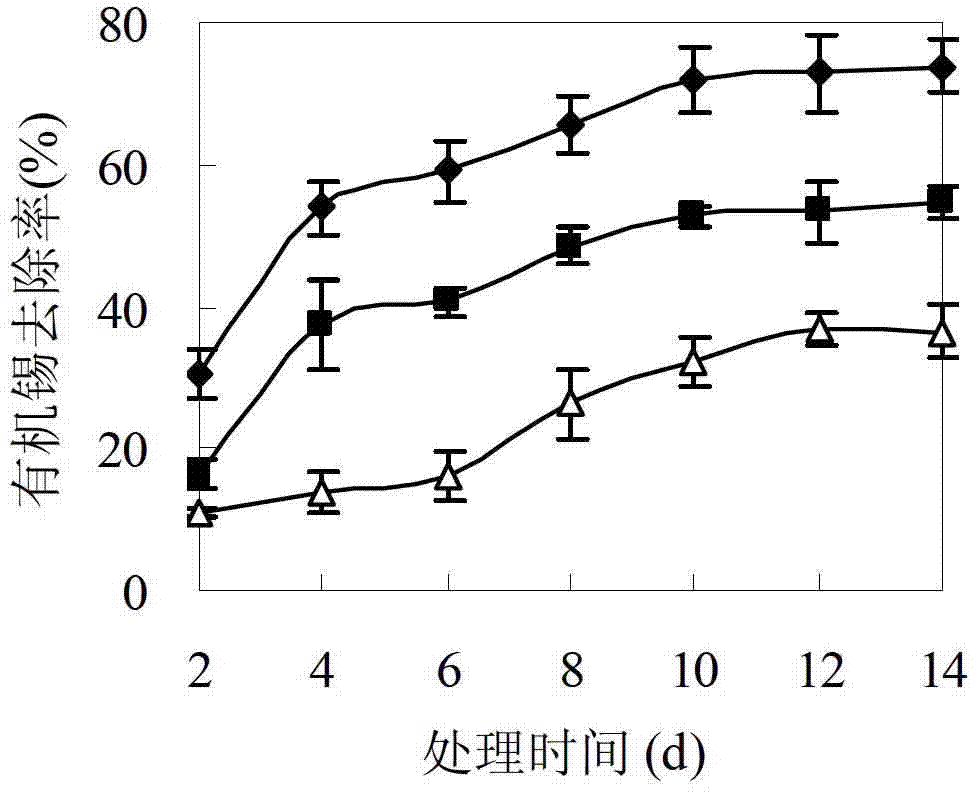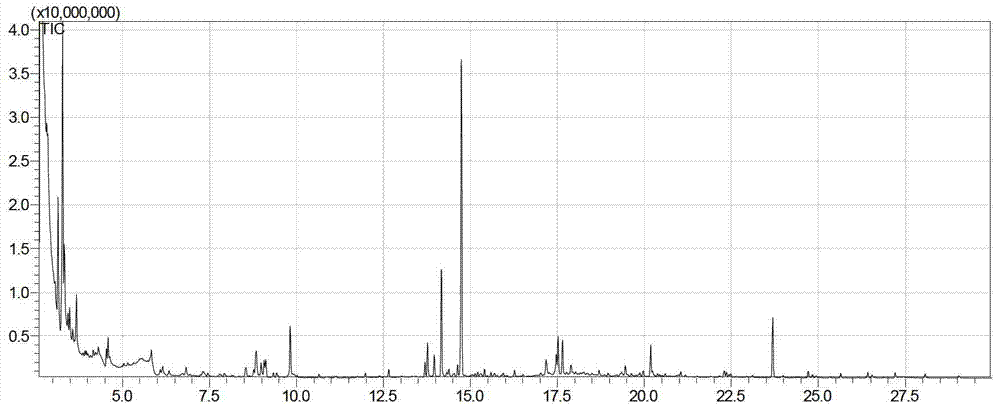Method for using organic tin-degrading bacteria agent and remediation plants to treat organic tin polluted water
A technology for repairing plants and organotin, applied in the field of environmental bioengineering, can solve problems such as unsatisfactory performance of degrading bacteria, long adaptation period of organotin toxicity, single degrading enzyme, etc., achieve superior effect, accelerate detoxification and complete degradation, and process efficiency high effect
- Summary
- Abstract
- Description
- Claims
- Application Information
AI Technical Summary
Problems solved by technology
Method used
Image
Examples
Embodiment 1
[0037] Example 1: Joint treatment of organotin-polluted river water bodies by organotin-degrading bacteria and restoration plants
[0038](1) Pick the organotin-degrading bacteria Bacillus thuringiensis (Bacillusthuringiensis, from the Lianjiang sediments, Guiyu Town, Guangdong Province, from the slant of the organotin-degrading bacteria. The same below.) and inoculate it into the seed medium (seed medium) at 25 mg / L Components: beef extract 3g / L, peptone 10g / L, NaCl 5g / L.), in a 50r / min shaker for 10h, the organic tin degradation bacteria liquid was obtained; take the organic tin degradation bacteria liquid by 1% The volume ratios were respectively inoculated in the medium prepared according to the ingredients in Table 1, and placed in a fermenter for cultivation, and the effect of the medium components on the culture of the bacteria was investigated. When the bacterial density of the organotin-degrading bacteria reaches 5g / L, the bacterial cells are harvested by centrifugati...
Embodiment 2
[0050] Example 2: Joint treatment of organotin-contaminated wharf sewage by organotin-degrading bacteria and restoration plants
[0051] (1) Pick the organotin-degrading bacteria Bacillus thuringiensis from the slope of the organotin-degrading bacteria and inoculate it into the seed medium at 1 mg / L (seed medium composition: beef extract 10g / L, peptone 2g / L, NaCl 0g / L.), in a 100r / min shaker for 15h, the organotin-degrading bacteria solution was obtained; the organotin-degrading bacteria solution was inoculated in the culture medium at a volume ratio of 5% (medium composition: beef extract 12g / L, peptone 3g / L, NaCl 0g / L.), placed in a fermenter for cultivation, when the bacterial density of organotin-degrading bacteria reached 9g / L, the bacterial cells were harvested by centrifugation at 3000rpm, dried at 100°C, and obtained Bacillus inoculum;
[0052] The cultivation is carried out at a dissolved oxygen percentage of 80wt%, pH 5.8, and a temperature of 30°C;
[0053] (2) ...
Embodiment 3
[0057] Example 3: Joint treatment of organotin-contaminated seabed mud by organotin-degrading bacteria and restoration plants
[0058] (1) Pick the organotin-degrading bacteria Bacillus thuringiensis from the slope of the organotin-degrading bacteria and inoculate it into the seed medium at 50 mg / L (seed medium composition: beef extract 6g / L, peptone 5g / L, NaCl 8g / L.), after shaking and culturing in a shaker at 200r / min for 24h, the organotin-degrading bacterial liquid was obtained; the organotin-degrading bacterial liquid was inoculated in the culture medium at a volume ratio of 10% (medium composition: beef extract 8g / L, peptone 8g / L, NaCl 8g / L.), placed in a fermenter for cultivation, when the bacterial density of organotin-degrading bacteria reached 12g / L, the bacterial cells were harvested by centrifugation at 3000rpm, dried at 60°C, and obtained Bacillus inoculum;
[0059] The cultivation is carried out at a dissolved oxygen percentage of 80wt%, pH 5.8, and a temperat...
PUM
| Property | Measurement | Unit |
|---|---|---|
| wavelength | aaaaa | aaaaa |
Abstract
Description
Claims
Application Information
 Login to View More
Login to View More - R&D
- Intellectual Property
- Life Sciences
- Materials
- Tech Scout
- Unparalleled Data Quality
- Higher Quality Content
- 60% Fewer Hallucinations
Browse by: Latest US Patents, China's latest patents, Technical Efficacy Thesaurus, Application Domain, Technology Topic, Popular Technical Reports.
© 2025 PatSnap. All rights reserved.Legal|Privacy policy|Modern Slavery Act Transparency Statement|Sitemap|About US| Contact US: help@patsnap.com



